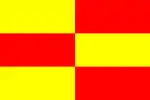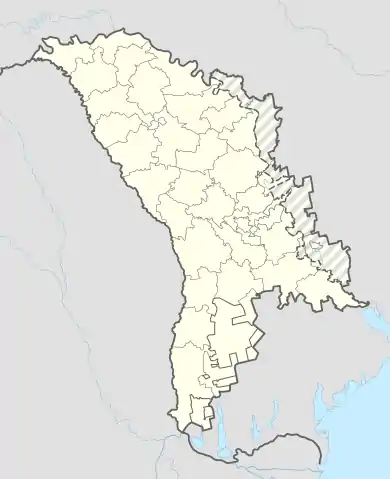Briceni
Briceni (Romanian pronunciation: [briˈt͡ʃenʲ]) is a city in northern Moldova. It is the seat of Briceni District.
Briceni | |
|---|---|
City | |
.jpg.webp) Briceni City Hall | |
 Flag  Seal | |
 Briceni Location within Moldova | |
| Coordinates: 48°21′40″N 27°05′02″E | |
| Country | Moldova |
| district | Briceni District |
| Area | |
| • Total | 10 km2 (4 sq mi) |
| Elevation | 39 m (128 ft) |
| Population | |
| • Total | 7,314 |
| • Density | 730/km2 (1,900/sq mi) |
| Time zone | UTC+2 (EET) |
| • Summer (DST) | UTC+3 (EEST) |
| Climate | Dfb |
Demographics
At the 2004 census, the city had a population of 8,765. At the 1930 census, there were two localities: Briceni Târg (literally Briceni Fair), and Briceni Sat (literally Briceni village), and at the time they were part of Plasa Briceni of Hotin County.
| Ethnic composition | ||||
| Ethnic group | 1930 census | 2004 census | 2014 census | |
| Briceni Târg | Briceni Sat | |||
| Moldovans | - | - | 3,344 | 3,165 |
| Romanians | 57 | 153 | 67 | 254 |
| Jews | 5,354 | 63 | 52 | N/A |
| Ruthenians and Ukrainians | 144 | 2,773 | 4,271 | 2,719 |
| Russians | 52 | 98 | 737 | 551 |
| Gypsies | – | – | 185 | 106 |
| Bulgarians | 1 | – | 26 | 15 |
| Gagauzians | – | – | 14 | 14 |
| Poles | 10 | 64 | 3 | 62 |
| Germans | 2 | 8 | 66 | |
| Greeks | 5 | – | ||
| Hungarians | – | 1 | ||
| others | – | – | ||
| Total | 5,625 | 3,160 | 8,765 | 7,314 |
| Native language | |||
| Language | 1930 census | 2004 census | |
| Briceni Târg | Briceni Sat | ||
| Romanian | 64 | 123 | N/A |
| Yiddish | 5,348 | 63 | N/A |
| Ukrainian | 123 | 2,790 | N/A |
| Russian | 83 | 162 | N/A |
| Polish | – | 16 | N/A |
| German | 6 | 6 | N/A |
| Bulgarian | 1 | – | N/A |
| others | – | – | N/A |
| Total | 5,625 | 3,160 | 8,765 |
Etymology
The town has been also called: Berchan, Bricheni, Bricheni Târg, Bricheni Sat, Britchan, Britchani, Britsiteni.
A village, approximately 50 kilometres (30 mi) to the east to the city, is also known as Briceni. It is at 48° 22´ north latitude and 27° 42´ east longitude, which puts that town 174 km (108 mi) north northwest of Chişinău.
Climate
| Climate data for Briceni (1991–2020) | |||||||||||||
|---|---|---|---|---|---|---|---|---|---|---|---|---|---|
| Month | Jan | Feb | Mar | Apr | May | Jun | Jul | Aug | Sep | Oct | Nov | Dec | Year |
| Average high °C (°F) | −0.3 (31.5) |
1.8 (35.2) |
7.7 (45.9) |
15.5 (59.9) |
21.3 (70.3) |
24.6 (76.3) |
26.6 (79.9) |
26.3 (79.3) |
20.6 (69.1) |
13.8 (56.8) |
6.6 (43.9) |
1.0 (33.8) |
13.8 (56.8) |
| Daily mean °C (°F) | −3.1 (26.4) |
−1.6 (29.1) |
3.1 (37.6) |
9.9 (49.8) |
15.4 (59.7) |
18.9 (66.0) |
20.7 (69.3) |
20.2 (68.4) |
14.9 (58.8) |
9.1 (48.4) |
3.4 (38.1) |
−1.6 (29.1) |
9.1 (48.4) |
| Average low °C (°F) | −5.7 (21.7) |
−4.5 (23.9) |
−0.7 (30.7) |
4.9 (40.8) |
10.0 (50.0) |
13.7 (56.7) |
15.4 (59.7) |
14.7 (58.5) |
10.1 (50.2) |
5.3 (41.5) |
0.8 (33.4) |
−4.0 (24.8) |
5.0 (41.0) |
| Average precipitation mm (inches) | 29 (1.1) |
33 (1.3) |
32 (1.3) |
44 (1.7) |
68 (2.7) |
87 (3.4) |
95 (3.7) |
55 (2.2) |
57 (2.2) |
44 (1.7) |
41 (1.6) |
33 (1.3) |
618 (24.3) |
| Average precipitation days (≥ 1.0 mm) | 7 | 7 | 7 | 7 | 9 | 9 | 9 | 6 | 7 | 7 | 7 | 8 | 88 |
| Mean monthly sunshine hours | 63 | 87 | 144 | 204 | 270 | 287 | 301 | 286 | 202 | 140 | 67 | 58 | 2,103 |
| Source: NOAA[2] | |||||||||||||
Jewish community

| 1817 | The town (then a fair) had 137 Jewish families. Another 47 had previously left when the village was partly destroyed by fire. |
| 1847 | Jewish school opened. |
| 1850 | Briceni had one of the largest Jewish communities in Bessarabia. |
| 1885 | Jewish hospital founded. |
| 1897 | There were 7,184 Jews in Bricheni (96.5% of the total population) |
| 1898 | The town had 7,303 Jews out of a total population of 8,094. There were 972 Jewish artisans, most of whom were furriers who produced and exported up to 25,000 fur overcoats and caps per year. 25 families were dedicated to gardening and to producing tobacco. About 700 Jews were day laborers, earning 10–30 kopeck per day. |
| 1924 | 125 Jews were occupied in agriculture on 64 km² (approx. 1,600 acres) of land, most of it (5 km²) held on lease. |
| 1930 | 5354 Jews (95.2% of the total population). There was a Hebrew Tarbut school. |
| 1940 | Jewish population grew to about 10,000. |
| June, 1940 | Briceni, along with the rest of Bessarabia was occupied by the USSR. Most Jewish property and community buildings were confiscated. The only synagogue was saved because the Soviets decided to use it as a granary. About 80 Jews, mostly community leaders, were exiled to Siberia. |
| July 8, 1941 | German & Romanian troops passed through the town, murdering many Jews. Jews from the neighboring towns of Lipcani (then Lipcani Târg) and Sokyriany (then Secureni Târg) were brought to Briceni. |
| July 28, 1941 | All Jews were dispatched across the river Dniester (outside Bessarabia) and several were shot en route. When they arrived in Mohyliv-Podilskyi, the Germans "selected" the old people and forced the younger ones to dig graves for them. From Mohyliv-Podilskyi the rest were turned back to Otaci and then on to Secureni-Târg. Hundreds died en route. For a month they stayed in the ghetto there, only to be deported again to Transnistria in late 1941. All the young Jews were murdered in a forest near Soroca. |
| After 1945 | Only about 1,000 Jews returned to Briceni at the end of the World War II. |
The Jewish cemetery of Briceni contains some 3,250 remaining tombstones though it is heavily overgrown and many are illegible. It is located in the eastern vicinities of the town, left of the road R11 leading to Ocnița.
History
On 5 December 2022, during a Russian bombing campaign against Ukraine during the 2022 Russian invasion of Ukraine, a missile fell within the borders of Moldova into an orchard near Briceni.[3] This was only the second such incident in Moldova, as previously on 31 October, a Russian rocket had fallen into the village of Naslavcea.[4] Later, on 14 January 2023, another missile fell into the village of Larga[5][6] and again on the same village on 16 February of the same year.[7] As a result of the latter incident, residents of Briceni expressed fear.[8] On 25 September, a missile crashed into Chițcani, for the first time in Moldovan territory controlled by Transnistria.[9]
Media
- Radio Chișinău 102,6 FM
References
- Results of Population and Housing Census in the Republic of Moldova in 2014: "Characteristics - Population (population by communes, religion, citizenship)" (XLS). National Bureau of Statistics of the Republic of Moldova. 2017. Retrieved 1 May 2017.
- "Briceni Climate Normals 1991–2020". World Meteorological Organization Climatological Standard Normals (1991–2020). National Oceanic and Atmospheric Administration. Archived from the original on 21 August 2023. Retrieved 21 August 2023.
- "MAI, cu noi detalii despre despre racheta căzută la Briceni: "La moment nu există niciun risc pentru cetățeni"" (in Romanian). Unimedia. 5 December 2022.
- "O rachetă rusească a căzut pe teritoriul R. Moldova. Mai multe case din Naslavcea, avariate". Radio Europa Liberă Moldova (in Romanian). 31 October 2022.
- Tanas, Alexander; Holmes, David; Popeski, Ron; Oatis, Jonathan (14 January 2023). "Moldova says missile debris found in north of the country". reuters.com. Reuters. Retrieved 15 January 2023.
- "Rocket debris found again in Moldova, from war next door". apnews.com. Associated Press. 14 January 2023. Retrieved 15 January 2023.
- "Resturile unei rachete lansate de Rusia au căzut în Republica Moldova, la 10 kilometri de granița cu România" (in Romanian). Digi24. 16 February 2023.
- "(video) "Ne este frică": Locuitorii orașului Briceni, despre racheta căzută la Larga" (in Romanian). Unimedia. 16 February 2023.
- Bodnar, Oxana (25 September 2023). "O rachetă S-300, de producție sovietică, a explodat deasupra Transnistriei. Focosul proiectilului a căzut în gospodăria unui localnic - detalii exclusive" (in Romanian). HotNews.